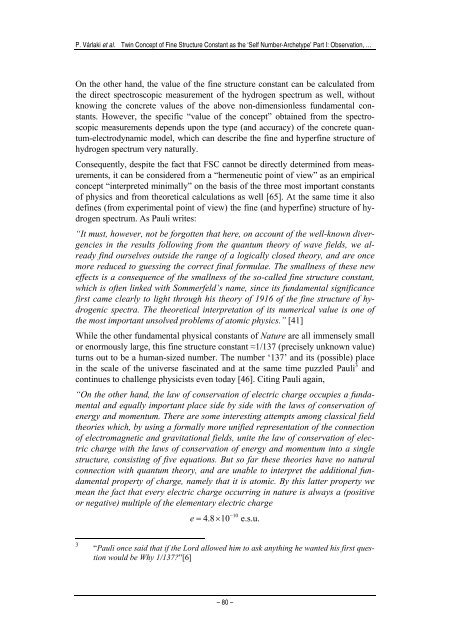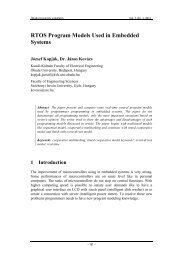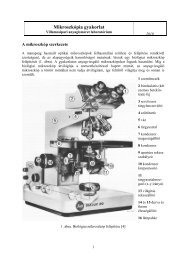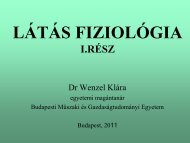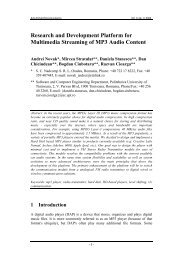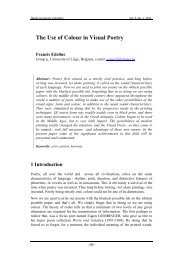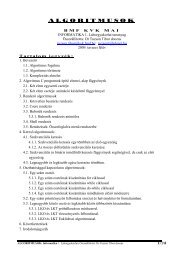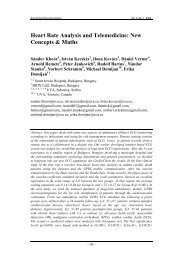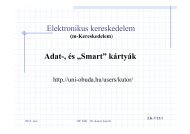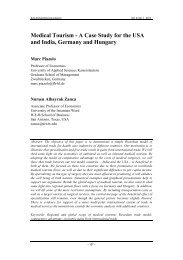Twin Concept of Fine Structure Constant as the 'Self Number ...
Twin Concept of Fine Structure Constant as the 'Self Number ...
Twin Concept of Fine Structure Constant as the 'Self Number ...
Create successful ePaper yourself
Turn your PDF publications into a flip-book with our unique Google optimized e-Paper software.
P. Várlaki et al. <strong>Twin</strong> <strong>Concept</strong> <strong>of</strong> <strong>Fine</strong> <strong>Structure</strong> <strong>Constant</strong> <strong>as</strong> <strong>the</strong> ‘Self <strong>Number</strong>-Archetype’ Part I: Observation, …<br />
On <strong>the</strong> o<strong>the</strong>r hand, <strong>the</strong> value <strong>of</strong> <strong>the</strong> fine structure constant can be calculated from<br />
<strong>the</strong> direct spectroscopic me<strong>as</strong>urement <strong>of</strong> <strong>the</strong> hydrogen spectrum <strong>as</strong> well, without<br />
knowing <strong>the</strong> concrete values <strong>of</strong> <strong>the</strong> above non-dimensionless fundamental constants.<br />
However, <strong>the</strong> specific “value <strong>of</strong> <strong>the</strong> concept” obtained from <strong>the</strong> spectroscopic<br />
me<strong>as</strong>urements depends upon <strong>the</strong> type (and accuracy) <strong>of</strong> <strong>the</strong> concrete quantum-electrodynamic<br />
model, which can describe <strong>the</strong> fine and hyperfine structure <strong>of</strong><br />
hydrogen spectrum very naturally.<br />
Consequently, despite <strong>the</strong> fact that FSC cannot be directly determined from me<strong>as</strong>urements,<br />
it can be considered from a “hermeneutic point <strong>of</strong> view” <strong>as</strong> an empirical<br />
concept “interpreted minimally” on <strong>the</strong> b<strong>as</strong>is <strong>of</strong> <strong>the</strong> three most important constants<br />
<strong>of</strong> physics and from <strong>the</strong>oretical calculations <strong>as</strong> well [65]. At <strong>the</strong> same time it also<br />
defines (from experimental point <strong>of</strong> view) <strong>the</strong> fine (and hyperfine) structure <strong>of</strong> hydrogen<br />
spectrum. As Pauli writes:<br />
“It must, however, not be forgotten that here, on account <strong>of</strong> <strong>the</strong> well-known divergencies<br />
in <strong>the</strong> results following from <strong>the</strong> quantum <strong>the</strong>ory <strong>of</strong> wave fields, we already<br />
find ourselves outside <strong>the</strong> range <strong>of</strong> a logically closed <strong>the</strong>ory, and are once<br />
more reduced to guessing <strong>the</strong> correct final formulae. The smallness <strong>of</strong> <strong>the</strong>se new<br />
effects is a consequence <strong>of</strong> <strong>the</strong> smallness <strong>of</strong> <strong>the</strong> so-called fine structure constant,<br />
which is <strong>of</strong>ten linked with Sommerfeld’s name, since its fundamental significance<br />
first came clearly to light through his <strong>the</strong>ory <strong>of</strong> 1916 <strong>of</strong> <strong>the</strong> fine structure <strong>of</strong> hydrogenic<br />
spectra. The <strong>the</strong>oretical interpretation <strong>of</strong> its numerical value is one <strong>of</strong><br />
<strong>the</strong> most important unsolved problems <strong>of</strong> atomic physics.” [41]<br />
While <strong>the</strong> o<strong>the</strong>r fundamental physical constants <strong>of</strong> Nature are all immensely small<br />
or enormously large, this fine structure constant ≈1/137 (precisely unknown value)<br />
turns out to be a human-sized number. The number ‘137’ and its (possible) place<br />
in <strong>the</strong> scale <strong>of</strong> <strong>the</strong> universe f<strong>as</strong>cinated and at <strong>the</strong> same time puzzled Pauli 3 and<br />
continues to challenge physicists even today [46]. Citing Pauli again,<br />
“On <strong>the</strong> o<strong>the</strong>r hand, <strong>the</strong> law <strong>of</strong> conservation <strong>of</strong> electric charge occupies a fundamental<br />
and equally important place side by side with <strong>the</strong> laws <strong>of</strong> conservation <strong>of</strong><br />
energy and momentum. There are some interesting attempts among cl<strong>as</strong>sical field<br />
<strong>the</strong>ories which, by using a formally more unified representation <strong>of</strong> <strong>the</strong> connection<br />
<strong>of</strong> electromagnetic and gravitational fields, unite <strong>the</strong> law <strong>of</strong> conservation <strong>of</strong> electric<br />
charge with <strong>the</strong> laws <strong>of</strong> conservation <strong>of</strong> energy and momentum into a single<br />
structure, consisting <strong>of</strong> five equations. But so far <strong>the</strong>se <strong>the</strong>ories have no natural<br />
connection with quantum <strong>the</strong>ory, and are unable to interpret <strong>the</strong> additional fundamental<br />
property <strong>of</strong> charge, namely that it is atomic. By this latter property we<br />
mean <strong>the</strong> fact that every electric charge occurring in nature is always a (positive<br />
or negative) multiple <strong>of</strong> <strong>the</strong> elementary electric charge<br />
e = ×<br />
−10<br />
4.8 10 e.s.u.<br />
3<br />
“Pauli once said that if <strong>the</strong> Lord allowed him to <strong>as</strong>k anything he wanted his first question<br />
would be Why 1/137?”[6]<br />
– 80 –


